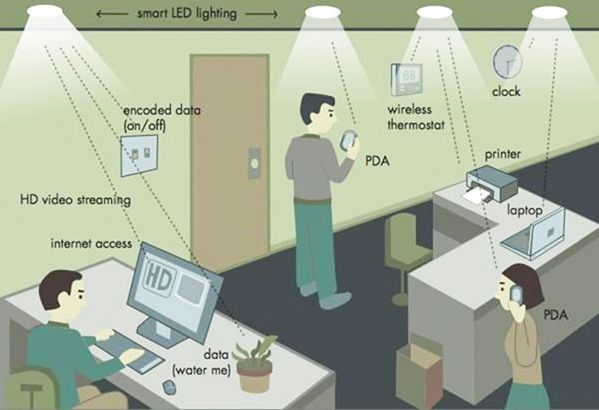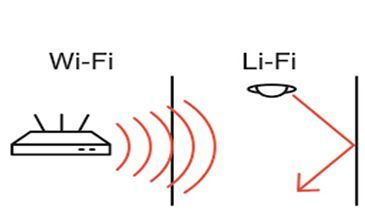The ubiquitous nature of the Internet is probably one of the main reasons for making our lives the way they are today. In the current scenario, it has become a necessity of the modern world. It not only connects all devices, from gaming consoles to digital cameras, but also allows you to remotely operate electronic devices through IoT. However, the capabilities of the Internet are not limited to excess knowledge about using Wi-Fi. Another superior technology of Li-Fi will eventually change our perception of the Internet.
As we know, Wi-Fi is a commonly used wireless technology that uses radio waves to connect devices to the Internet, but with the growing demand and increasing network congestion, the current technology will not be able to provide the desired results for a long time. . Consequently, by exploring the possibility of alternative choices, the term 'Li-Fi' was created.
Here we will illustrate the concept of Li-Fi technology, how it works and how it differs from conventional Wi-Fi technology.

Li-Fi: using visible light for extremely fast data transmission
What is Li-Fi?
Li-Fi, short for Light Fidelity, is a wireless technology that uses visible light communication instead of radio waves. To achieve this, common household LED bulbs can be used to allow data transfer at a speed of up to 224 gigabits per second, which is equivalent to downloading around 18 movies of 1.5 GB each every second.
This term was coined by professor Harald Haas during a TED TALK in 2011. Basically, with this technology, people will be able to use lamps and solar cells as wireless routers for data transmission. He even created a company called pureLiFi in 2012 and aims to be a world leader in visible light communications technology.

Diagram representing Li-Fi connections (image courtesy: ScienceAlert)
However, if we look at history, visible light communication has been used for a long time. In fact, the first demonstration of this technology occurred in 1880, when Alexander Graham Bell invented a photophone device that could transmit voice several hundred meters using sunlight. Therefore, the advent of Li-Fi technology indicates, in some ways, the return of tried and tested methods used for data transmission over fiber optic cables. Furthermore, it carries a new sophistication that can be universally adopted to meet the demands of a futuristic high-speed internet.
How it works?

Howe Li-Fi works (image courtesy: purelifi)
All existing wireless technologies use different frequencies in the electromagnetic spectrum. While Wi-Fi uses radio waves, Li-Fi captures information through visible light communication. Therefore, the latter requires a photodetector to receive light signals and a processor to convert the data into streamable content. As a result, the semiconductor nature of LED bulbs makes them a viable source of high-speed wireless communication.
So how does this work? Let's see how Li-Fi works:
When a constant current source is applied to an LED bulb, it emits a constant stream of photons observed as visible light. When this current varies slowly, the lamp dims up and down. Because these LED bulbs are semiconductors, the current and optical output can be modulated at extremely high speeds that can be detected by a photodetector device and converted back into electrical current.
Intensity modulation is too fast to be perceived by the human eye and therefore communication appears to be seamless, just like RF. Thus, the technique can help transmit information at high speed from an LED lamp. However, it is much simpler, unlike RF communication, which requires complex radio circuits, antennas and receivers.
Li-Fi uses direct modulation methods similar to those used in low-cost infrared communication devices such as remote control units. Furthermore, infrared communication has limited powers due to safety requirements, while LED lamps have sufficiently high intensities to achieve very high data rates.
Wi-Fi versus Li-Fi

Wi-Fi vs Li-Fi (image courtesy: Bloomberg)
Now that we know what Li-Fi is and how it works, the question is where it compares to Wi-Fi. To understand which one is superior, let's take a look at some aspects of both technologies:
Speed:
Li-Fi can provide data transfer speeds of 224 gigabits per second, which clearly leaves Wi-Fi behind. According to tests carried out by pureLiFi, the technology produced more than 100 Gbps in a controlled environment. Furthermore, the visible light spectrum is 1,000 times greater than the 300 GHz RF spectrum, which helps in gaining high speed.
Energy efficiency
Typically, Wi-Fi needs two radios to communicate, which takes a lot of power to discern signal from noise as there may be multiple devices using the same frequency. Each device has an RF transmitter and a baseband chip to enable communication. However, because Li-Fi uses LED lights, transmission requires minimal additional power to enable communication.
Security
One of the main differences between Wi-Fi and Li-Fi is that the former has a wider range (typically 32 meters) and can even be accessed in different parts of a building, however, the latter cannot penetrate walls and ceilings. and therefore it is safer.
While this would mean installing a separate LED lamp in every room, the technology could be ideal for sensitive operations like R&D, Defense, Banking, etc. -Fi.
Data density
Due to interference issues, Wi-Fi works in a less dense environment while Li-Fi works in a highly dense environment. The area covered by a Wi-Fi access point has 10 or 100 seconds of lights, and each LiFi light can provide the same or greater speed as a Wi-Fi access point. Therefore, in the same area, LiFi can provide capacity without wire 10, 100 or 1000 times larger.
Li-Fi technology projects
With the increasing demand for data transfer and the high congestion on existing Wi-Fi networks, the need to develop an alternative to high-speed Internet has become crucial. As a result, many companies are working on technology for easy access and superior quality of data transfer.
Mentioned below are some companies involved in developing and exploring the possibilities of Li-Fi as a futuristic Internet service:
• pureLiFi
It was founded by Professor Harald Haas and Mostafa Afghani in 2012. The startup tested its technology with customers such as Cisco Systems and British Telecommunications. It has also partnered with French lamp manufacturer Lucibel to launch Li-Fi-equipped pendant lights.
• VLNComm
Mohammad Noshad and Maite Brandt-Pearce founded VLNComm in 2013. Supported by the US Department of Energy and the National Science Foundation, the team is in partnership talks with US government agencies. Its latest pendant light prototype reaches 25 Mbps, while the next one is expected to reach 100 Mbps due to advances in coding, modulation and signal processing.
• Velmenni
It is a company founded by Deepak Solanki and Saurabh Garg in 2012. The team developed a credit card-sized router prototype capable of converting off-the-shelf LED lights into Li-Fi transmitters. It is also developing Li-Fi applications for aircraft cabins and cockpits, as well as hardware for outdoor use.
• Eindhoven University of Technology
The team of researchers from this university led by Joanne Oh has developed a Li-Fi system that uses harmless infrared rays. The system's data capacity is 40 Gbit/s per day due to wavelengths measuring 1,500 nanometers and more. According to Joanne, the team achieved speeds of up to 42.8 Gbots/s at a distance of 2.5 meters.
Other notable names include i2cat, ByteLight, Basic6, etc. Additionally, some other established organizations have also shown interest in working on the technology. The technology was tested by a telecommunications provider based in the United Arab Emirates. Furthermore, if market reports are to be believed, Apple could build future iPhones with Li-Fi capabilities.
Conclusion
Wi-Fi has undoubtedly been a blessing for all of us, but factors such as increased congestion, interference with sensitive equipment and bandwidth saturation clearly indicate the shortcomings of the current technology. Li-Fi, on the other hand, digitizes the world by manipulating light to transmit information using low-power technology. Additionally, features like high-speed data transfer and privacy further favor the use of Li-Fi over Wi-Fi.
Although it is impossible to replace Wi-Fi with Li-Fi due to the existing infrastructure, it can certainly emerge as an imperative option for certain companies, airplanes, hospitals, etc. , it's more like using both technologies according to usage requirements.

